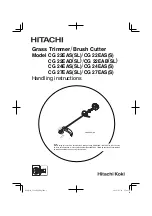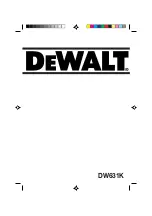
— US-12 —
4. Operate the throttle trigger a few times to make
sure that it works rightly.
5. Adjust the cable adjuster sleeve so the stop on the
carburetor throttle cam contacts the idle speed
adjustment screw and the cable position keep
1-2mm play between cable lug and slotted fittings
when the throttle trigger is fully depressed.
6. When the throttle cable is adjusted correctly,
tighten the locknut.
7. Reinstall the air filter cover and tighten the knob.
Before Operation
Oil and Fuel
1. Do not smoke near fuel.
2. Mix and pour fuel outdoors and where there are
no sparks or flames.
3. Always shut off the engine before refueling.
Never remove the fuel tank cap while the engine
is running or just right after stopping the engine.
4. Always open the fuel tank cap slowly to release
any possible overpressure inside the tank.
5. Do not overfill the fuel tank. Stop filling 1/4-1/2
in. (6 mm-13 mm) from the top of the tank.
6. Tighten the fuel tank cap carefully but firmly after
refilling.
7. Wipe up any spilled fuel before starting the
engine.
8. Move the Hedge trimmer at least 10 ft. (3m) away
from the fueling location and fuel storage
container before starting the engine.
POTENTIAL HAZARD
• In certain conditions gasoline is extreme-
ly flammable and highly explosive.
WHAT CAN HAPPEN
• A fire or explosion from gasoline can
burn you, others, and cause property
damage.
HOW TO AVOID THE HAZARD
• Use a funnel and fill the fuel tank out-
doors, in an open area, when the engine
is cold. Wipe up any gasoline that spills.
• Do not fill the fuel tank completely full.
Add gasoline to the fuel tank until the
level is 1/4 to 1/2 in. (6 mm to 13 mm)
below the bottom of the filler neck. This
empty space in the tank allows gasoline
to expand.
• Never smoke when handling gasoline,
and stay away from an open flame or
where gasoline fumes may be ignited by
a spark.
• Store gasoline in an approved container
and keep it out of the reach of children.
• Never buy more than a 30-day supply of
gasoline.
DANGER
WARNING
POTENTIAL HAZARD
• Gasoline contains gasses that can build
up pressure inside a gas tank.
WHAT CAN HAPPEN
• Fuel can be sprayed on you when
removing gas cap.
HOW TO AVOID THE HAZARD
• Remove fuel cap slowly to avoid injury
from fuel spray.
10 ft. (3 m) minimum
Summary of Contents for EH230DSL
Page 75: ......














































